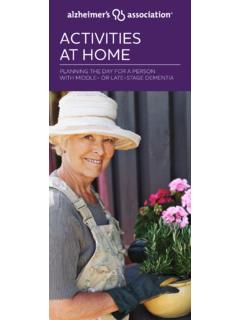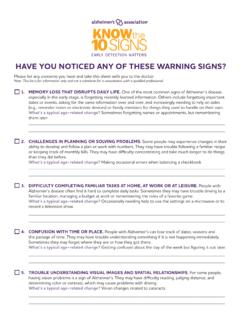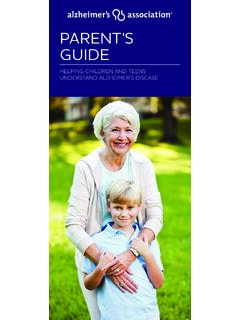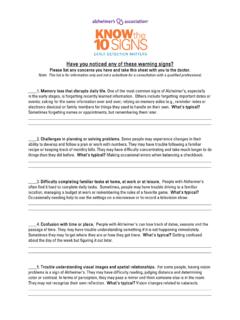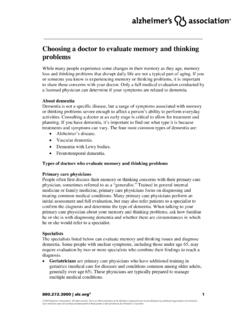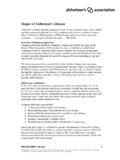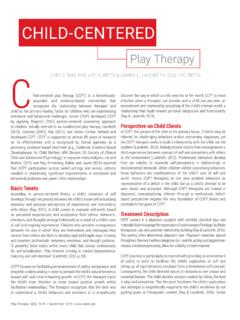Transcription of Person Centered Care in Nursing Homes and Assisted Living
1 Page 1 of 5 Person Centered care Updated 07/2017 2017 Alzheimer s Association, Greater Missouri Chapter. All rights reserved. This is an official publication of the Alzheimer s Association but may be distributed by unaffiliated organizations and individuals. Such distribution does not constitute an endorsement of these parties or their activities by the Alzheimer s Association. Greater Missouri Chapter 24/7 Helpline: serving 96 counties in MO and Western IL Person Centered care in Nursing Homes and Assisted Living We all desire optimal quality of life and personalized long-term care for our elders. We want to select care options that afford the best opportunity for Person Centered care . There have been many recent innovations in care practices for persons with dementia but they are not universally available. This tip sheet is a quick primer on what is referred to as a Culture Change in long term care .
2 These tips are designed to familiarize Alzheimer s families and advocates about the tools, guides, language and resources available to understand and foster a Person Centered long term care . Hopefully, it will help you identify the best philosophy of care that meets your needs and your loved one s needs. What does Person - Centered care mean? Person Centered care is a focus on elders (residents' and clients') emotional needs and care preferences, consistent with their lifestyle. The emphasis is on relationships in the care (Social Model), rather than task- Centered approaches that focus on physical health of elders (Medical Model). Although the term Person - Centered approach (PCA); Person Centered care (PCC) or resident Centered care (RCC) is starting to be referred to more in the healthcare lingo', many may misunderstand its meaning. When seeking Person Centered care , families will want to know how care providers learn about, and support each Person 's holistic needs and preferences.
3 Person Centered care considers the Person s relationships and the impact that other people, practices, physical care and the environment may have on the individual. (Kitwood, 1997; Brooker, 2004). Core characteristics of the approach are: Respecting and valuing the individual as a full member of society Providing individualized emotional and physical spaces for care that are in tune with people's changing needs Understanding the perspective of the Person in all care and activities Providing supportive opportunities for social engagement to help people live their life and experience well-being. Is Person - Centered care the Norm? No, but it is becoming more available. For many years pioneers have championed the idea that those receiving long-term care in Nursing Homes and Assisted Living are best served by what has become known as Person - Centered care To fully realize this type of care , a significant change in the way we think about long term care is underway.
4 This is a broad and deep change in both consumer and providers mindset and in service delivery. There is a substantial change in the culture of long-term care currently taking place. Not all health care providers have accepted this innovation and culture change. But those who have done so show that it is possible to deliver Person - Centered care that is both cost-effective and highly satisfying to those receiving the care and to their families, as well as care professionals providing that care . While many approaches are developing, the core values that unite them are choice, dignity, respect and self determination. Given the benefits, especially for the recipients of care , a large and growing number of providers, consumers, policy makers, professional associations, and long-term care leaders believe we must move forward to the broad-scale spread in Person Centered care .
5 Page 2 of 5 Person Centered care Updated 07/2017 2017 Alzheimer s Association, Greater Missouri Chapter. All rights reserved. This is an official publication of the Alzheimer s Association but may be distributed by unaffiliated organizations and individuals. Such distribution does not constitute an endorsement of these parties or their activities by the Alzheimer s Association. Culture Change Terms Culture change refers to the progression from institutional or traditional models of care to more individualized, consumer-directed practices that embrace choice and autonomy for care recipients and providers. "Culture change" is an innovation anchored in values and beliefs that return the locus of control to elders and those who work closest with them. Its ultimate vision is to create a culture of aging that is inclusive, life-affirming, satisfying, humane, and meaningful.
6 Required changes: Culture change requires changes in organizational practices, physical environments, workplace practices, and relationships. Goal: Long-term care environments become places where elders can continue to live and, most importantly, make their own choices and have control over their daily lives. This kind of care not only enhances quality for consumers and staff but also creates opportunities for the health care providers to improve in quality of care , efficiency, revenue and stable staffing. Culture Change Improvements Many families are seeking a long term care setting with a quality improvement approach shifting from: Medical Model = Old School; institutional model, top down power structures and a medical orientation Social Model = New Vision; a Person - Centered model distinguished by smaller Living areas, flexible and inclusive staff roles and an administrative commitment to empower those who work closest to residents, to help make care decisions.
7 Common elements of culture change include: Resident-direction in care and daily activities Home atmosphere Close relationships between residents, family members and staff Staff empowerment Collaborative decision-making Quality improvement processes Importance of Language: Language is important in the change to Person Centered care . Language can either support change efforts or undermine them. Concepts of personalization and relationship-building cannot take root when a resident requiring assistance at mealtime is referred to as a "feeder; or when the act of walking is referred to as "ambulation." Purposeful lives unfold in communities, not in "facilities". Reference the last page of this tip sheet for examples of ways language needs to change as the care culture changes. The widely-used language of long-term care continues to reflect an institutional orientation.
8 Part of a change effort must be thoughtful consideration of the words and expressions used to describe the care provided and the way people and spaces are referred to in long term care communities. For instance, the term "resident" emphasizes the special relationships between Person and place and Person and community that the term "patient" fails to evoke. You may find that each long term care community uses different language that works best for their customers . Newer approaches are commonly characterized in one of these ways: " Person - Centered ," "resident-directed," "resident- Centered " and "relationship- Centered ." The important common threads are the core values of focusing care on the meaningful needs of the Person . Since the people residing at any one time in a care community change, culture change is referred to as a journey not a destination and the care providers should be in a continuous process of assessment, creative responses and evaluation of their a Person Centered care strategies.
9 Page 3 of 5 Person Centered care Updated 07/2017 2017 Alzheimer s Association, Greater Missouri Chapter. All rights reserved. This is an official publication of the Alzheimer s Association but may be distributed by unaffiliated organizations and individuals. Such distribution does not constitute an endorsement of these parties or their activities by the Alzheimer s Association. Components of Person Centered care : Long Term care Communities are diverse, each having their own identity. This is a list of tangible resident- Centered practices which consumers should see and experience in long-term care communities engaged in culture change. Residents Living in Nursing Homes that provide resident Centered care have: Resident- Centered Systems for Getting to Know Residents Examples: Life Story Interview & document, Preferences Inventory, All About Me Form Creative, Non departmental Staffing approaches Examples: Consistent staff, universal worker job descriptions, Neighborhood Team Leaders, All Hands Philosophy, care Partners Maximizing Independence Examples: residents go to bed and wake when they want; bathing choices based on residents preferences, individualized medication administration (not a line up), activities that interest a resident rather than one size fits all approach and only big group activities.
10 The Move-In Experience emphasizes building relationships and feelings of home, not a medical admission Examples: A welcome committee, welcome rituals, a buddy system for both families and residents, a system for notifying and introducing staff, families and residents of a new neighbor and a well developed orientation or transitions program for families and elders. Understanding Community Norms- see above Focusing on Possibilities, Not Limitations Examples: Using the Person s life story and integrating it into care plan. Use of the I care plan , Fitness, wellness and enrichment programs, resident-directed decision-making Supporting the Community Through Grief and Loss Examples: Determining and honoring resident and family preferences around end of Life care , Five Wishes or Tranquil passages programs, healing circles, memorial rituals and services that acknowledge deaths, comfort quilts, programs that assist staff, residents and families with loss Spirituality Supports- See above Examples: Blessing of the Staff s Hands, pastoral care services, sacred spaces, reflection rooms Culinary Engagement Examples: Eat what they want, when they want.
